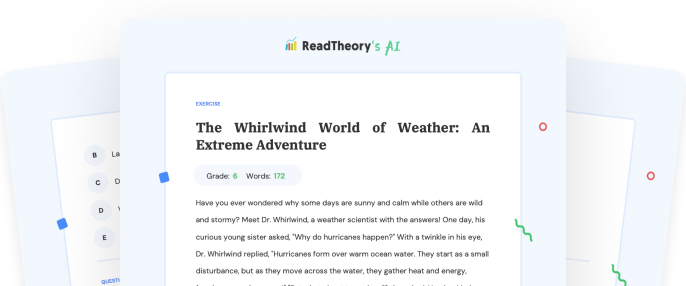Transform Your Teaching
with AI-Powered Worksheets
With ReadTheory’s Instant Worksheet Builder, you can create engaging, grade-appropriate worksheets tailored to your students in minutes. Spark curiosity, save time, and empower critical thinking with AI-powered tools designed for teachers like you.


The Northern Lights: A Dance of Science and Myth
In the Arctic skies, a spectacle of nature unfolds with auroras - the Northern Lights, casting an ethereal glow over the snowy landscape. But how does this vibrant dance of colors occur? The story begins 93 million miles away, on the Sun. Charged particles from the Sun's surface are hurled into space, creating solar wind. This wind reaches Earth, and something magical happens. Our planet's magnetic field serves as a shield, deflecting most particles. However, those that seep in towards the poles interact with our atmosphere, creating a light show. The particles collide with oxygen and nitrogen, exciting them. What follows is a release of light as they return to their normal state - the glow we see as the Northern Lights. The varying colors, from green to pink and purple, depend on the type of gas and the altitude at which the collision occurs. But to many indigenous cultures, these lights are more than a scientific phenomenon. They are a source of myth and legend. The Inuit people, for instance, believe that the lights are spirits of their ancestors, playing a game of football with a walrus skull. Others see them as pathways to the afterlife. The Northern Lights are thus a marvel of both science and imagination. They represent the cosmos’s power and our human need to make sense of the natural world, highlighting a fascinating intersection of science and mythology.
Question 1
What triggers the occurrence of the Northern Lights?
The collision of solar wind particles with Earth's atmosphere
The reflection of sunlight on the Arctic ice
The illumination of the Arctic by the moon
The glow emitted by animals in the Arctic
The reflection of city lights on the Arctic clouds
Question 2
What does the Inuit people's interpretation of the Northern Lights represent?
The celebration of a successful hunt
The spirits of their ancestors playing football with a walrus skull
The arrival of a new season
A warning of an impending natural disaster
A sign of good luck
Question 3
What does the color variation of the Northern Lights depend on?
The season of the year
The temperature in the Arctic
The time of the day
The type of gas and the altitude at which the collision occurs
The position of the stars
Question 4
What does the term 'solar wind' refer to in the text?
The wind blowing in the Arctic region
The breeze created by the movement of the Sun
The gust of air felt during a solar eclipse
The charged particles hurled into space from the Sun's surface
The atmospheric pressure created by the Sun's heat
Question 5
True or false: The Northern Lights are only a scientific phenomenon.
True
False
Can't say
Sometimes true, sometimes false
Dependent on observer's perspective
 or share via
or share via

Assign the ReadTheory pretest to determine students' reading levels.

Why Teachers Love
Instant Worksheet Builder?

Tailored Content for Every Student
Craft worksheets with passages and multiple-choice questions customized to your chosen topic and grade level, ensuring relevance and engagement.

Save Hours
of Prep Time
Our AI, Lexi, generates complete worksheets—passages, questions, and answers—in minutes, freeing you to focus on teaching, not planning.

Standards-Aligned Learning
Every worksheet is designed to boost reading comprehension and critical thinking, aligning seamlessly with State Standards to help your students shine.
Personalized teaching
for personalized learning
Browse worksheets created and refined by educators using Lexi—your source for inspiration and ready-to-use resources.


ReadTheory is free for Teachers to use.
Join thousands of educators using ReadTheory for free. Sign up today and start creating in just minutes!





